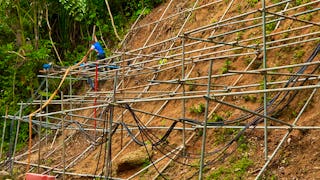This course ranges from the earth structure, the generation of earthquakes and seismic waves by faults to the seismic response of soils, foundations and structures as well as seismic risk. It is consequently aimed at undergraduates, graduates and professionals interested in engineering seismology, earthquake engineering or seismic risk. It investigates various technical fields: rock mechanics, soil dynamics, structural dynamics and dynamic soil-structure interaction.

Enjoy unlimited growth with a year of Coursera Plus for $199 (regularly $399). Save now.

Seismology to Earthquake Engineering



Instructors: Jean François Semblat
6,917 already enrolled
Included with
(38 reviews)
Recommended experience
What you'll learn
How seismic waves propagate
How earthquakes are generated
How structures withstand seismic shaking
Skills you'll gain
Details to know

Add to your LinkedIn profile
10 assignments
See how employees at top companies are mastering in-demand skills

There are 6 modules in this course
What's included
1 video
The first week allows to discover the Earth structure, the plate tectonics, the behaviour of faults in the crust and the radiation of seismic waves. The seismicity of the Earth is studied and that of Mars is shown as well! The control of faults and the magnetic properties of the Earth are finally explained.
What's included
11 videos2 assignments
Various types of seismic waves are presented through both actual observations and theoretical interpretation. Their propagation and amplification in heterogeneous geological structures are discussed (soil layers, alluvial basins). The application to site characterization is finally proposed.
What's included
8 videos2 assignments
The seismic soil response is analyzed first. The simplified soil response is then converted into a so-called response spectrum for sake of seismic design. The seismic response of structures is discussed through eigenmodes, modal superposition and modal recombination. Seismic isolation and in situ dynamic characterization of structures is also presented.
What's included
10 videos3 assignments
Dynamic Soil-Structure Interaction and Soil-Foundation-Structure Interaction are presented first. Typical nonlinear behaviours of structures are then analyzed. The seismic response of structures is finally discussed through simplified (e.g. push-over) and time history nonlinear analyses.
What's included
8 videos2 assignments
Vulnerability and damage assessment are introduced first. They are illustrated for masonry structures in the field and concrete structures on shaking tables. The effect of uncertainties is then discussed in order to derive fragility curves. Finally catastrophe and loss models are explained.
What's included
7 videos1 assignment
Instructors



Offered by
Explore more from Environmental Science and Sustainability
 Status: Free Trial
Status: Free TrialL&T EduTech
 Status: Preview
Status: PreviewUniversity of Illinois Urbana-Champaign
 Status: Free Trial
Status: Free TrialDartmouth College
 Status: Preview
Status: PreviewThe Hong Kong University of Science and Technology
Why people choose Coursera for their career




Learner reviews
38 reviews
- 5 stars
63.15%
- 4 stars
13.15%
- 3 stars
10.52%
- 2 stars
2.63%
- 1 star
10.52%
Showing 3 of 38
Reviewed on Jun 5, 2023
Overall good!Both video content and explanations...

Open new doors with Coursera Plus
Unlimited access to 10,000+ world-class courses, hands-on projects, and job-ready certificate programs - all included in your subscription
Advance your career with an online degree
Earn a degree from world-class universities - 100% online
Join over 3,400 global companies that choose Coursera for Business
Upskill your employees to excel in the digital economy
Frequently asked questions
To access the course materials, assignments and to earn a Certificate, you will need to purchase the Certificate experience when you enroll in a course. You can try a Free Trial instead, or apply for Financial Aid. The course may offer 'Full Course, No Certificate' instead. This option lets you see all course materials, submit required assessments, and get a final grade. This also means that you will not be able to purchase a Certificate experience.
When you purchase a Certificate you get access to all course materials, including graded assignments. Upon completing the course, your electronic Certificate will be added to your Accomplishments page - from there, you can print your Certificate or add it to your LinkedIn profile.
Yes. In select learning programs, you can apply for financial aid or a scholarship if you can’t afford the enrollment fee. If fin aid or scholarship is available for your learning program selection, you’ll find a link to apply on the description page.
More questions
Financial aid available,

